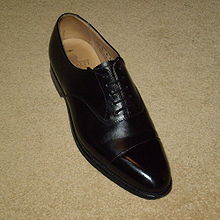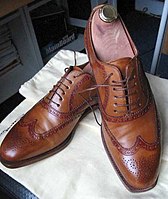Oxford shoe
This article needs additional citations for verification. (December 2013) |

An Oxford shoe is a type of shoe characterized by shoelace eyelet tabs that are attached under the vamp,[1] a feature termed "closed lacing".[2] This contrasts with Derbys, or bluchers, which have shoelace eyelets attached to the top of the vamp.[3] Originally, Oxfords were plain, formal shoes, made of leather, but they evolved into a range of styles suitable for formal, uniform, or casual wear. On the basis of function and the dictates of fashion, Oxfords are now made from a variety of materials, including calf leather, faux and genuine patent leather, suede, and canvas. They are normally black or brown, and may be plain or patterned (brogue).
Terminology
[edit]The meaning of "Oxford" and "balmoral" may vary geographically. In the United States and Scotland, "Balmoral" is often synonymous with "Oxford".[4] In the United States, "Oxford" is sometimes used for any more formal lace-up shoe, including the Blucher and Derby. In Britain and other countries, the Balmoral is an Oxford with no seams, apart from the toe cap seam, descending to the welt, a style common on boots. Oxford shoes are also known for their variation or style. The Cap-Toe Oxford is the most well-known, although 'Whole Cut', 'Plain Toe', and a variation of 'Brogue' Oxfords are commonly referred to styles.[5] Shoes with closed lacing (Oxfords/Balmorals) are considered more formal than those with open lacing (Bluchers/Derbys).[6] A particular type of oxford shoe is the wholecut oxford, its upper made from a single piece of leather with only a single seam at the back or in the rare exception no seams at all.[7]
History
[edit]Oxfords first appeared in Scotland and Ireland, where they are occasionally called Balmorals after Balmoral Castle. However, the shoes were later named Oxfords after Oxford University. This shoe style did not appear in North America until the 1800s.[8] In the United States, Oxfords are called "Bal-type" as opposed to "Blucher-type". In France, Oxfords are known as Richelieu,[9] or Molière in Belgium and Luxembourg.
Oxfords were derived from the Oxonian, a half-boot with side slits that gained popularity at Oxford University in 1800.[10] Unlike early shoes, Oxfords were cut smaller than the foot. The side slit evolved into a side lace that eventually moved to the instep, as students rebelled against knee-high and ankle-high boots. The toe cap can either be lined with two narrow rows of stitching, perforated holes along the end cap stitching (quarter-brogue), perforated holes along the end cap stitching and on the toe cap (semi-brogue), or a semi-brogue with the classical wingtip design (full-brogue).[11]
-
Evening Oxford shoes created by Alfred J. Cammeyer in 1891
-
Men's quarter brogue oxford shoes
-
Men's full brogue (or wingtip) oxford
See also
[edit]- Blucher shoe
- Brogue shoe
- Derby shoe
- Saddle shoe
- "The Short Happy Life of the Brown Oxford"
- Spectator shoe
- Wholecut
References
[edit]- ^ Hibbert, Christopher, ed. (1988). "Oxford Shoe". The Encyclopaedia of Oxford. Macmillan. p. 304. ISBN 0-333-39917-X.
- ^ "The Derby Shoe & Blucher Guide — Gentleman's Gazette". www.gentlemansgazette.com. 12 June 2014. Retrieved 11 November 2015.
- ^ Schneider, Sven Raphael (12 June 2014). "The Derby Shoe & Blucher Guide — Gentleman's Gazette". www.gentlemansgazette.com. Retrieved 7 September 2019.
- ^ "The History of the Oxford Shoe / Steptronic Footwear". steptronicfootwear.co.uk. Retrieved 7 September 2019.
- ^ "Oxford Shoe | Information Guide". Thomas George Collection. Retrieved 13 November 2020.
- ^ "FASHION TRENDING – WHAT ARE OXFORD SHOES: FASHION/TEXTILE INDUSTRY (WHAT ARE OXFORD SHOES)". Finderz Keeperz.
- ^ "Oxford Shoes Guide - How To Wear Oxfords, How To Buy & What To Avoid — Gentleman's Gazette". www.gentlemansgazette.com. 13 February 2019. Retrieved 7 September 2019.
- ^ "What are oxford shoes?". Conjecture Corporation. Retrieved 6 February 2017.
- ^ "Top Five Dress Shoes for Men & Wardrobe Collection | Best 5 Dress Shoe Styles". Old Martin. 3 March 2019. Retrieved 7 September 2019.
- ^ "The Oxford Shoes Guide — Gentleman's Gazette". www.gentlemansgazette.com. Retrieved 11 November 2015.
- ^ "Nothing like a new pair of Oxfords". J.L. Rocha Collections. 6 April 2014. Retrieved 7 September 2019.
External links
[edit] Media related to Oxford shoes at Wikimedia Commons
Media related to Oxford shoes at Wikimedia Commons



